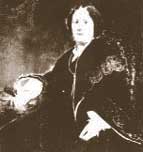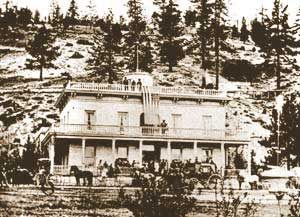
Nevada Historical Society, Reno
The information below has been compiled from a variety of sources. If the reader has access to information that can be documented and that will correct or add to this woman’s biographical information, please contact the Nevada Women’s History Project.
At A Glance:
Born: September 6, 1826
Died: October 27, 1903
maiden name: Oram
Race/Nationality/Ethnic Background: Caucasian-Scottish
Married: Stephen Hunter, Alexander Cowan, Lemuel Sanford (Sandy) Bowers
Children: three (two died in infancy; one daughter, adopted)
Primary City and County of Residence and Work:
Gold Hill (Storey Co.), Washoe Valley (Washoe Co)
Major Fields of Work: Mining (mine owner), Business (boarding house, resort owner), Seeress
Other Role Indentities: Wife, Mother
Eilley Bowers is one of the most researched, written and talked about women in Nevada history. From the days of living in her mansion in Washoe Valley as a millionaire mine owner, to her final days as a poor fortuneteller living alone in the King’s Daughters Home in Oakland, CA, she was a continual subject of news reports and writers who sometimes wrote tales of her long, eventful life. In the years since the Reno Women’s Civic Club helped the city of Reno purchase her mansion in Washoe Valley, researchers have tried to uncover the facts of her life. The following is the result of years of in-depth research used to distinguish the difference between truth and fiction.
Alison (Eilley) Oram was born on Septrmber 6, 1826 in the Royal Burgh of Forfar, Scotland, located in the eastern Scottish countryside. At the young age of fifteen, she married nineteen-year- old Stephen Hunter of Fishcross, Clackmannan, Scotland. After six years of marriage, Stephen converted to the relatively new religion of the Church of Jesus Christ of Latter Day Saints.
In January 1849, the Hunters decided to move to America and the new Mormon city in the Great Salt Lake Valley. Brigham Young had built this city for his followers just two years earlier. The Hunters emigrated to America by ship from Liverpool, England to New Orleans, then by steamer to Council Bluffs, Iowa, where they joined a wagon train and walked the rest of the way to the Great Salt Lake City. Soon after they arrived, the two were divorced for unknown reasons.
Three years later in 1853, Eilley married another Mormon, Alexander Cowan. Alexander was also from Scotland and was a devout Mormon willing to do anything for the church. In the fall of 1855, Alexander was called on a mission to the western most edge of Utah Territory. Today this is Genoa, Nevada, but then it was the small settlement of Mormon Station in Carson County, Utah Territory. Most women stayed in Salt Lake City when their husbands went off to settle a new community, but Eilley chose to go with her husband and his 12-year-old-nephew Robert Henderson, who had recently been orphaned.
When their first winter approached, most of the Mormons returned to Salt Lake City, but Alexander and Eilley stayed in the small settlement. The following spring, Orson Hyde, the Mormon leader, decided to move the Mormons to Washoe Valley. Since the Cowans stayed behind for the winter, they were among the first to arrive in the Valley. Alexander was able to purchase 320 acres of good farming land complete with a small house and corral.
A little over one year later, the U.S. government was having problems with the Mormon church which brought about the possibility of war between the church and the United States. In order to save his empire, Brigham Young called back all the Mormons who had been sent out to settle small communities like the one in Washoe Valley. In the fall of 1857, Alexander was faithful to the church and agreed to return to the Great Salt Lake City. Eilley and Robert chose to stay behind. After the problems with the government and Utah were over, Alexander returned to Eilley for a short time, but he soon went back to Salt Lake City alone.
When the settlement of Franktown was abandoned by the Mormons, Eilley and Robert moved to the small mining camp of Johntown (today it is below Silver City). The camp housed around 180 miners who were searching the surrounding streams for gold. Eilley built a small boarding house which became a welcome addition to the rustic camp. Eilley and her nephew lived in this camp until the spring of 1859 when gold was discovered on a nearby hill, and the town of Gold Hill was born.
Eilley and Robert quickly moved to Gold Hill and built a new boarding house. Eilley began to take advantage of the situation by claiming several plots of mining land. One of her claims lay right next to a claim owned by Lemuel Sanford (Sandy) Bowers. That August, Sandy and Eilley adjoined their claims and their lives when they were married. Soon Gold Hill and the new town of Virginia City were exciting and populated mining towns producing the most concentrated amount of silver in the United States. The Bowers were among the first millionaires of the Comstock Lode, and over the next two years, Eilley gave birth to two children. Unfortunately both died as infants.

Nevada Historical Society
Eilley took over the business matters of the mine with the help of George Waters, but the ore was gone and her financial situation was not good. Rather than give up, Eilley returned to her earlier role of boardinghouse keeper by turning her mansion into a resort. Nighttime parties and summer picnics became a way of life for Mrs. Bowers.
In 1870, she was forced to sell the mine to George Waters due to her financial problems, ending her career as a mine owner. In 1873, a new silver strike created a second boom for the Comstock Lode. This strike was called the Big Bonanza and brought new life to Virginia City and Nevada. With an increase in employment and money, the people of Virginia City and the surrounding communities found the need to celebrate, and Bowers Mansion seemed to be the most likely place to party. Afternoon picnics were commonly held during the summer months. The Miners Union, Knights of Pythias, the Pioneers, and many other organizations often sponsored large picnics. Thousands of local residents rode trains, brought their wagons and even walked to these grand affairs. Eilley was always considered the gracious hostess, but this did not help her financial situation.
At one point, she tried to raffle the mansion, but it had to be withdrawn since not enough tickets were sold to make the venture feasible. She built on a third story to the mansion to bring in more boarders, but this only increased her debt. Things were not going well for Eilley, but the picnics still continued. During this time, twelve-year- old Persia was sent to Reno to live and go to school. It is believed that this was to keep her from the party atmosphere surrounding the mansion. When there was a break between parties, Persia often came home for a visit. In July, 1874, just such a visit occurred. At the end of her time in the mansion, Eilley accompanied Persia to Reno, but she could not stay long since she had to host another picnic that Sunday. After the picnic, Eilley was told to return to Reno. By the time she arrived, it was too late. Persia had died of a ruptured appendix. She was then buried on the hillside behind the mansion next to her father. After the loss of her daughter, Eilley had to continue on. Three weeks later she hosted a picnic for all the Sunday School children from the surrounding towns.
After the death of three children and her husband, the loss of her mine and her money, and with the approaching loss of her mansion, she began to turn to her spirit friends for support. Eilley had been known to have a crystal ball from as early as her days in Johntown, but her fortune telling seemed to be more for fun than anything else. Now it was becoming a way of life.
In 1876 she finally lost the mansion when it was sold at public auction. Myron C. Lake, the new owner, allowed her to stay in the mansion that summer, but then she was forced to move. She had a small house in Franktown near her mansion, but she often stayed in Virginia City and Reno telling fortunes for money. Eilley had become a wanderer and professional seeress. She continued to live this life until 1882 when she suddenly disappeared from Nevada. She was later found living and working in San Francisco. In 1884 she returned to Reno for a short time and continued to tell fortunes, but she soon returned to San Francisco.
By the turn of the century, Eilley was financially destitute and was showing signs of senility. She was in her mid-seventies and had lived to see most of her friends die many years prior. Eilley began writing letters to everyone she knew trying to get their support in her effort to get money from the government. In the days before Nevada was a state, Sandy Bowers is believed to have given the government $14,000 to help fight the Indians in the Paiute Indian war of 1860. Eilley only wanted a little back to help pay for her final days and a decent burial. The money never came.
Eilley made one final return to Reno in the summer of 1901 and was put away in the county poor house. During her stay, she proved to be very troublesome for the caregivers, so the county commissioners tried to figure out what to do with her. They finally agreed that they could not help her, so they bought her a ticket on a train to San Francisco and bid her farewell. A local lawyer was able to gather together about $30 in donations to help send her on her way.
Eilley returned to San Francisco and later went to Oakland where she took up residency in the King’s Daughters Home. Eilley Oram Bowers died alone on October 27, 1903 at the age of seventy-seven. With the help of Henry Riter, the new owner of Bowers Mansion, Eilley’s ashes were returned to Nevada and were buried behind the mansion with her husband Sandy and daughter Persia.
In 1946 her mansion was purchased by Washoe County with the help of the Reno Women’s Civic Club and public donations. It is now a county park with a swimming pool, picnic grounds and tours through the mansion itself during the summer season. Within the mansion walls, Eilley’s story will continue to live on.
Biographical sketch by Tamera Buzick with assistance from Betty Hood, Curator, Bowers Mansion, and Andrew Crawford, great-grandnephew of Bowers
Sources of Information:
If you have questions or comments please send them to tbuzick@aol.com
- The research on Eilley, her family and the mansion is still ongoing since many mysteries still remain. Several people associated with the family have long since died and their descendants have yet to be found. The descendants of people like Robert, James and Elizabath Henderson, Harry and Al Livingston, Danial Neileigh, Henrietta (Hettie) Dettenreider Baker and Joseph A. Conboie might be able to help us solve some of the mysteries that still surround the mansion. If you feel you might be a descendent or if you have some information, please respond by writing Betty Hood at 4005 Old Highway 395, Washoe Valley, NV 89704 or by contacting Tamera Buzick by e-mail.
